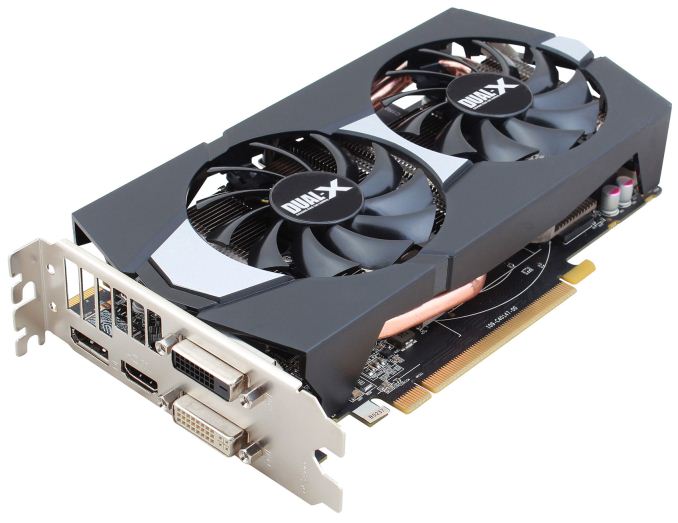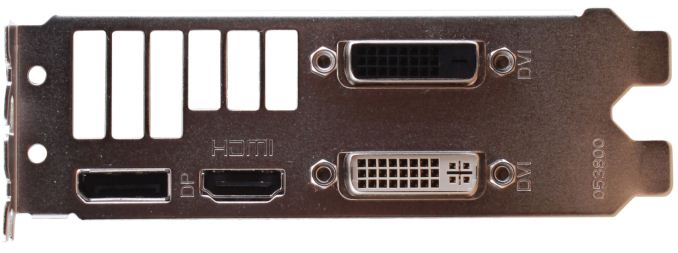The AMD Radeon R7 265 & R7 260 Review: Feat Sapphire & Asus
by Ryan Smith on February 13, 2014 8:00 AM ESTMeet The Sapphire Radeon R7 265
Since the R7 265 is a variant of the existing R7 270 series, AMD isn’t creating a reference card this time around. In lieu of that they have been sending the press Pitcairn cards reprogrammed to the 265 specification, which gives us something suitable to test but doesn’t necessarily represent what the final retail products will look like. For our sample we received a board based on Sapphire’s Radeon R9 270 Dual-X design.
Because we don’t know at this time whether this specific card will be a retail product or not, we’re not in a position to talk about it in depth. But we did want to discuss it briefly, as we expect most (if not all) retail R7 265 cards to be built in a similar manner, especially for the board partners reusing their existing R9 270 designs as was the case here.
Sapphire’s design is fairly typical for a 150W AMD card. Here Sapphire utilizes a compact form of their Dual-X cooler, relying on a pair of 75mm fans mounted over an aluminum heatsink, with a pair of copper heatpipes providing a connection between the heatsink and the Pitcairn GPU underneath. A baseplate brings the package together, providing cooling for the RAM and VRMs, relying on small grooves at various areas to function as a quasi-heatsink and improve convection. This means that it is of course an open air design, and while 150W is not trouble for most cases these days it does bear mentioning.
Sapphire’s Dual-X cooler runs 8.5” long, causing it to slightly overhang the 7.9” PCB. The card doesn’t feature a dedicated stiffening mechanism of any kind, but the baseplate is just large enough to provide the necessary rigidity on its own. Elsewhere the required 6pin PCIe power socket is located at far end of the PCB, orientated parallel to the PCB itself and slightly obscured by the card’s shroud; so you’ll need a bit more room behind the card to work in the necessary power cabling.
Finally, at the front end of the card we find half slot vent, coupled with AMD’s current generation I/O layout of 1x DisplayPort, 1x HDMI, and 2x DL-DVI. Notably, Sapphire has also added themselves to the pool of board partners with this design by using a wider grating spacing in an attempt to improve airflow, subdividing their vent into just 6 relatively large segments.













52 Comments
View All Comments
AlucardX - Thursday, February 13, 2014 - link
Since the 7850 was a great overclocker, I wonder how this rebadge product is. Any plans to overclocking with an increased Vcore?Ryan Smith - Thursday, February 13, 2014 - link
Not with this one. I only had 2 days to put this review together, so unfortunately there wasn't time for overclocking.krumme - Thursday, February 13, 2014 - link
Intel Core i7-4960X at 4.2GHz with a 260 playing BF4 single player.Perhaps not the most realistic scenario in this world.
MrSpadge - Thursday, February 13, 2014 - link
It shows you what the card can do. If you're concerned about your CPU limiting you in BF4 multi player.. well, better read a CPU review.krumme - Friday, February 14, 2014 - link
A user playing with the s260 will typically have dual core i3. Thats reality. Try that with or without mantle in Multiplayer 64 man on the big maps. It the difference between playable or not playable. Probably more than 50% difference in favor of mantle. Instaed we get this useless talk.Rebel1080 - Friday, February 14, 2014 - link
What you're getting here is the equivalent of an Xbox One for $119 or PS4 for $149. It took Nvidia and ATI about 12-18 months just to release a video card of equal or better performance for under $199 after the seventh generation's (Xbox 360/PS3) debut. The fact that it only took 3 months to get to this level for under $150 during this generation only shows just how much $ony and M$FT low balled it's customers on specs.silverblue - Friday, February 14, 2014 - link
Except you then have to factor in the rest of the hardware to that price. Think about it - CPU, cooling, motherboard, memory (I don't think 8GB of GDDR5 is cheap), storage, case, power supply, software and the all-important input devices. Add in the fact that developers will get more out of the console GPUs than with the PC and I think you're ragging on them a bit too much.Antronman - Wednesday, February 19, 2014 - link
You mean 4GBs of DDR3. And likely high CAS latency too. Low-watt GPUs. Software only costs how much you pay the employees. Input ports are part of the mobo. DEVs do not get more out of the console GPUs. They are actually underclocked so that you don't need desktop-grade cooling. Consoles will never be serious gaming machines. People who buy consoles either won't spend the money on a good PC, can't spend the money, or would rather spend the money on dozens of games that they'll only play a couple of hours of and then just stick to one game.golemite - Saturday, February 15, 2014 - link
270's inflated prices are directly the result of cryptocoin mining as it has been found to offer an advantageous Kilo-hash to Watt ratio. It would be interesting and helpful to many out there if Anandtech started publishing KH/sec and KH/watt metrics in its review for Scrypt mining.Will Robinson - Monday, February 17, 2014 - link
Nice addition to the AMD lineup.... and a pretty convincing demolition of NVDA's competing cards.Thanx for the review!